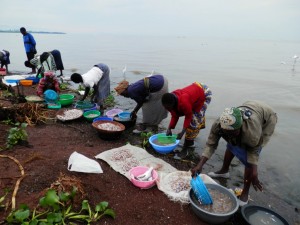On July 26, our community partner, Maurice, was married, and we GIVE travellers were lucky to be invited to take part in his wedding! It was wonderful to see a Kenyan wedding and all the traditions. There is a lot of dancing and singing throughout the ceremony. Much of it is meant to “entice” the bride to get married, promising gifts. Even in the church, the bride and the wedding party danced slowly down the aisle. We drove to the beautiful Kit Mikayi for wedding photos. The gifts received were very different than what you might expect at a Canadian wedding… my favourite was the goat!
The IYCF sessions held twice weekly have been going very well. Turnout ranges from approximately 20 – 35 mothers at each session. There have been some great questions about breastfeeding and local beliefs of what a young child can or cannot eat. I am hopeful that many of the mothers take some of the information we share and apply it to their home lives. If they keep the handouts they are given, they will have access to reference some of the information. I was very pleased to hear today from a mother that her child usually doesn’t eat nyuka (porridge) when she tries to feed it to him, but today he liked it! I have heard this before; it comes down to flavour. Without the added oil, sugar and fruit, plain porridge is not very good. This to me signals that our porridge lessons are working, and the mothers are learning how to make it nutritious and tasty!
This week I held the first of two CHW IYCF Training Sessions. With the District Nutrition Officer, Elizabeth, as co-facilitator, I talked about the 3 Food Groups, nutrition for women of reproductive age, nutrition for pregnant and lactating women, exclusive breastfeeding, food safety and hygiene, and malnutrition in children.
Only 3 food groups? Yes, in Kenya the food groups are organized differently than in Canada. The groups are:
- Energy foods, which are fats and carbohydrates, such as maize, cassava, oil and butter
- Body-building foods, which are proteins such as meats, fish, beans and lentils
- Protective foods, which refers to the vitamins and minerals found in fruits and vegetables, such as bananas, papaya, tomatoes and kale
Of course, we recognize that there is crossover of the foods found in each group (for example, meat is high in iron), but this classification makes meal planning quite simple.
I was very impressed with the amount of knowledge the CHWs had regarding these topics. Afterward, many of them told me that they were grateful for the new information they had received, and they learned many new things. They even sang me an ero kamano (thank you) song at the end of the session, which was very touching.

Women sort fish and shrimp on the banks of Lake Victoria. Omena – a tiny fish – is the main source of animal protein in the area.
The five day annual Agriculture Show took place this week in Kisumu. The atmosphere was very carnival-like, though there were no rides. There were many school children on field trips wandering through the exhibitions. We noticed how much better condition their clothes were in compared to students in our district. Many took lunch breaks in the shade and were drinking soda and eating snacks like potato chips; luxuries you would rarely see in Kanyawegi.
So many of the plants on display we Canadians take for granted, such as eggplant, rosemary, thyme, and dill; however, to Maurice they were new and exciting. I was pleased to see sac gardens on display in many exhibits! They called them “multistory gardens,” but the idea was the same. They were made of 3 or 4 sacs sewn together, and grew approximately 4.5’ tall; much larger than I’ve seen before. Around the base grew lettuce, and in the sacs were usually kale in the bottom half and spinach in the top half. Here the spinach is a Foodhook Giant variety, which looks a lot like Arctic Chard. There were some other innovative ideas like tire gardens, and integrated gardens. Integrated gardens utilize the space on top of chicken (or rabbit) coops to grow a leafy vegetable.
I also learned about an unrefined cane sugar that is fortified with a local dark green, leafy vegetable “crotolaria” or “miro.” It was very tasty, and provides some vitamins and minerals.

